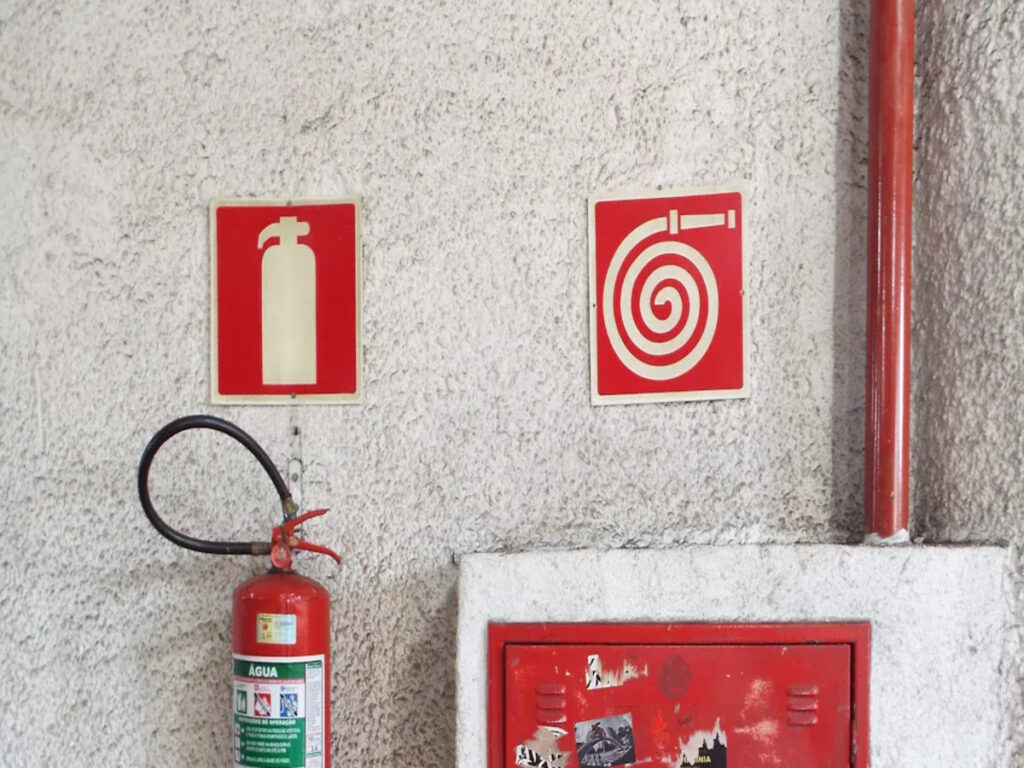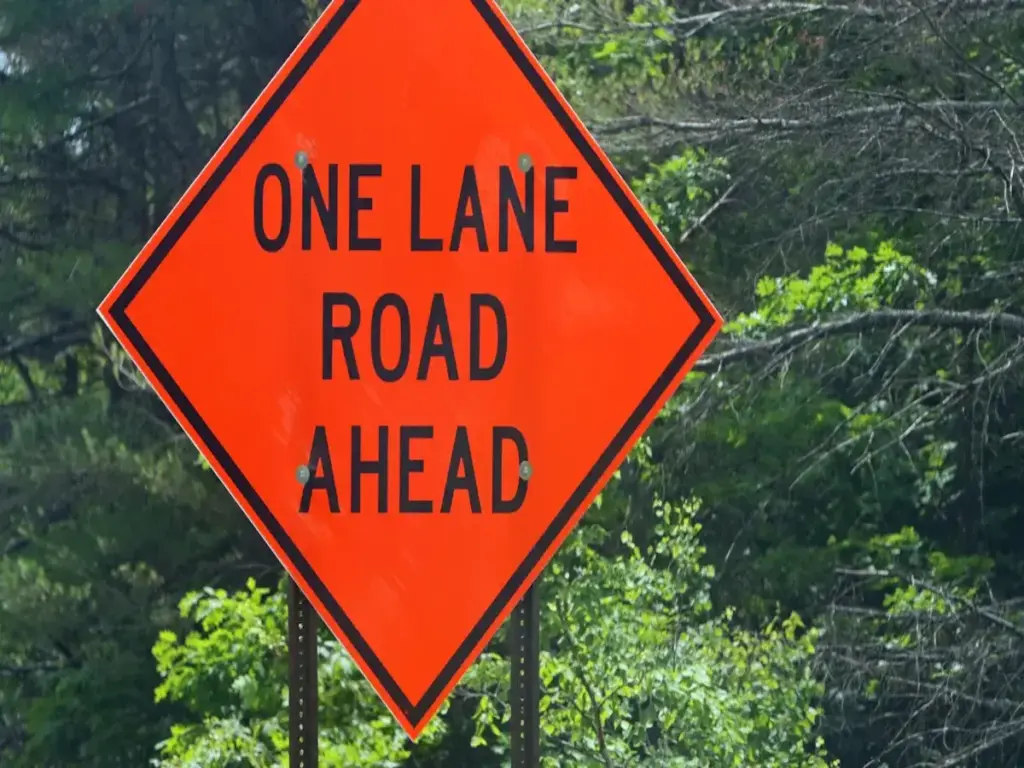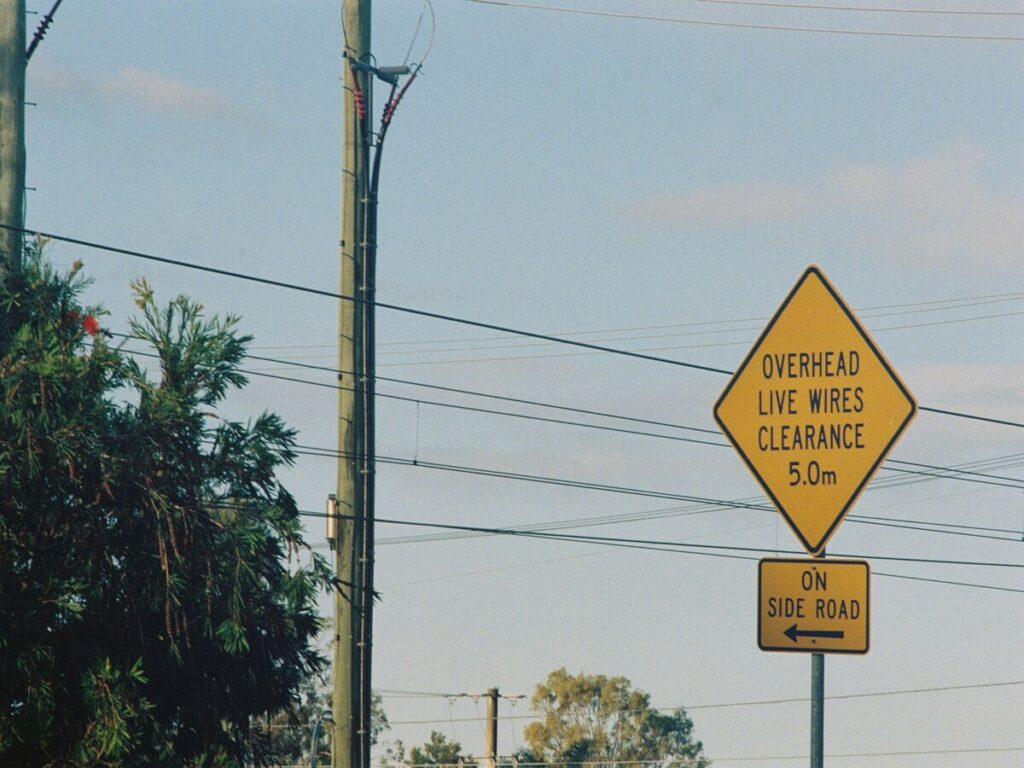
Beschaffungsmanager und Verkehrsplaner geraten beim Kauf oft in Verwirrung Verkehrszeichen für Projekte in anderen Ländern. Die in Australien und den USA verwendeten reflektierenden Blattklassen. unterscheiden sich signifikant. Dazu gehört die Klasse 1, Klasse 2, und Klasse 3 in Australien, Im Vergleich zur Grade des Ingenieurs, Hoher Intensität, und Diamantqualität in den USA. Solche Unterschiede beeinflussen die Wahl der Zeichen und ihre Wirksamkeit. Untersuchungen zeigen, dass die Verwendung besserer reflektierender Bleche auf Schildern Nachtunfälle um bis zu bis hin zu reduzieren kann 30%. Die Auswahl des entsprechenden Zeichens verbessert die Sichtbarkeit und verbessert die Verkehrssicherheit, vor allem in Gebieten mit starkem Verkehr. Zeichenhersteller und Fachkräfte für Straßensicherheit müssen diese Klassenunterschiede verstehen, um Verkehrszeichen zu kaufen, die den Vorschriften entsprechen und die Sicherheit aller Straßenbenutzer gewährleisten.
Reflektierende Folienkurse
Australien vs. UNS. Standards
Australien und die Vereinigten Staaten verwenden unterschiedliche Methoden zum Sortieren von reflektierenden Folien für Verkehrsschilder. In Australien, Die Als/nzs 1906 Der Standard listet drei Hauptklassen auf: Klasse 1, Klasse 2, und Klasse 3. Diese Kurse zeigen, wie hell und robust die Folie für verschiedene Schilder sein muss. Klasse 1 Funktioniert gut für die meisten normalen Verkehrsschilder, aber Klasse 3 ist am hellsten und wird an wichtigen Orten eingesetzt.
Die Vereinigten Staaten verwenden den MUTCD-Standard. Es hat Namen wie Engineer Grade, Hoher Intensität, und Diamantqualität. Engineer Grade ist für weniger wichtige Zeichen vorgesehen. High-Intensity und Diamond Grade sind heller und werden für Hauptschilder und stark befahrene Straßen verwendet.
Notiz: Beide Standards sorgen für Sichtbarkeit beim Kauf von Verkehrsschildern, unterscheiden sich jedoch in der Terminologie und der Helligkeitsmessung.
Schlüsselunterschiede
The biggest difference is how each system sorts the grades. Australia uses numbers, but the U.S. uses names. This can make it hard to pick the right sheeting for signs in other countries.
| Reflektierende Note | Australien (Als/nzs 1906) | UNS. (MUTCD) |
|---|---|---|
| Entry Level | Klasse 2 | Ingenieurqualität |
| Mid-Level | Klasse 1 | Hoher Intensität |
| Prämie | Klasse 3 | Diamantqualität |
Studies show RA2 (like High-Intensity) is easier to see than RA1 (wie Engineer Grade). RA2 signs are brighter and help drivers follow the rules better. Zum Beispiel, RA2 white signs can be as bright as 180 cd·lx⁻¹·m⁻², but RA1 only gets to 50 cd·lx⁻¹·m⁻². This means RA2 signs are easier to spot, Besonders nachts.
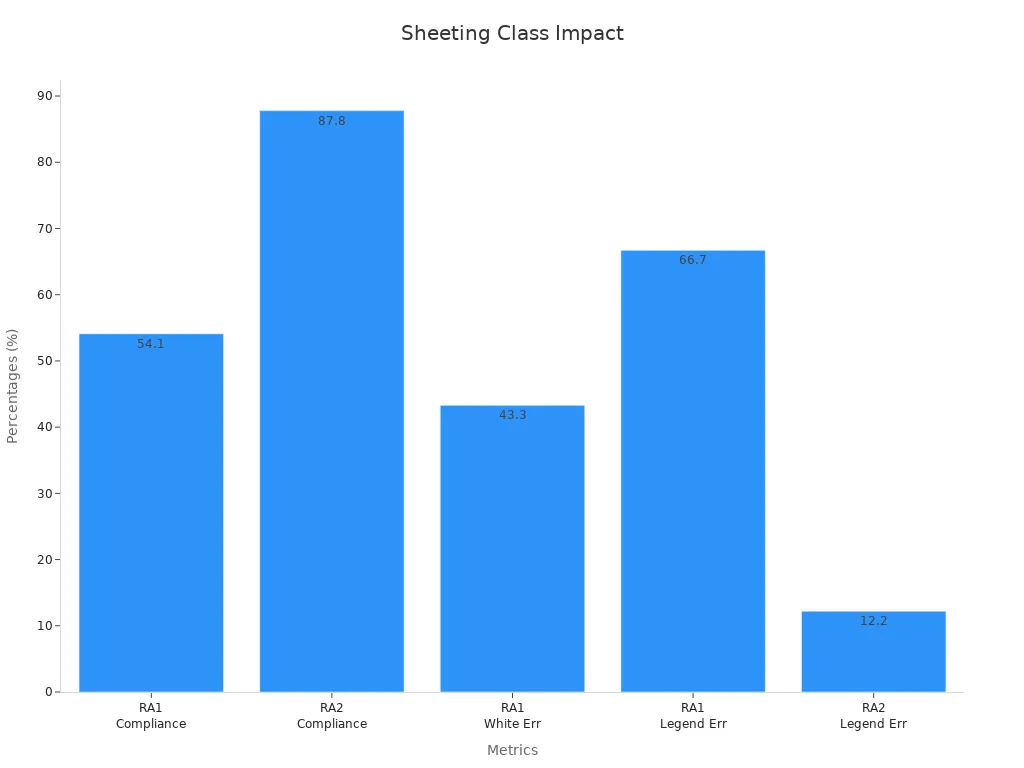
Common Misunderstandings
People who buy signs for projects in other countries sometimes mix up the grades. They might choose Engineer Grade instead of High-Intensity for important signs, which makes the signs hard to see. If the brightness drops below 100 cd·lx⁻¹·m⁻², drivers may not see the signs well. Bad weather and glare can make this problem worse.
Tipp: Verwenden Sie beim Kauf von Verkehrsschildern immer die reflektierende Folienklasse, die den örtlichen Vorschriften und den Anforderungen der Straße entspricht. Dies trägt zur Sicherheit aller bei und befolgt die Gesetze.
Auswirkungen auf die Sichtbarkeit von Verkehrszeichen
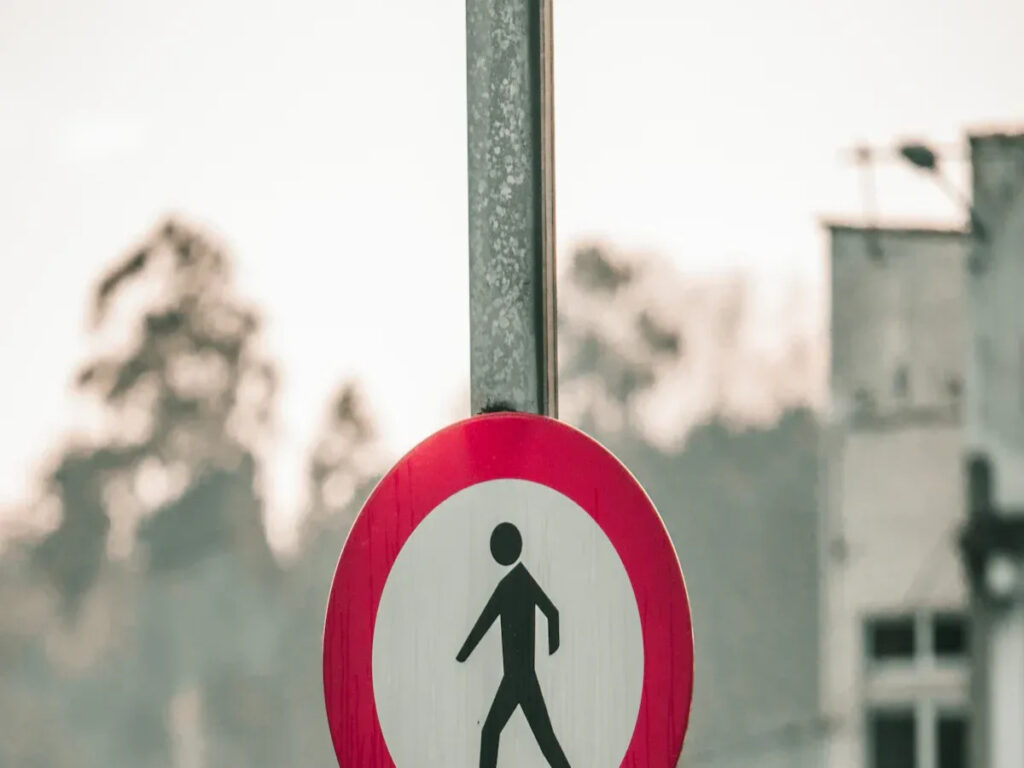
Reflexionsvermögen und Leistung
Reflektierende Folien helfen Autofahrern, Verkehrsschilder besser zu erkennen. Die Art der reflektierenden Folie verändert die Helligkeit des Schildes. Hochwertige reflektierende Folie, Wie Klasse 3 oder Diamantqualität, glänzt mehr. Diese Schilder sind schon von weitem und unter Autoscheinwerfern zu erkennen. Dies ist für die Sicherheit auf stark befahrenen Straßen sehr wichtig. Reflektierende Folie der unteren Klasse, wie Klasse 2 oder Ingenieurgrad, ist nicht so hell. Bei Dunkelheit oder Regen sind diese Schilder schwerer zu erkennen. Wenn die falsche Klasse verwendet wird, Autofahrer könnten wichtige Schilder übersehen. Dies erschwert das Lesen von Schildern und kann zu mehr Unfällen führen. Gute Sichtbarkeit trägt dazu bei, dass Schilder hervorstechen, auch auf stark befahrenen Straßen.
Notiz: Wählen Sie beim Kauf von Verkehrsschildern die richtige reflektierende Folie aus. Dies trägt dazu bei, dass alle auf der Straße sicher sind.
Umweltfaktoren
Wetter und Klima können die Wirkungsweise reflektierender Folien beeinflussen. Dinge wie Hitze, Regen, und Sonnenlicht kann dazu führen, dass die Folie schneller verschleißt. An Orten mit sehr heißem oder nassem Wetter, Die Anzeichen halten möglicherweise nicht so lange an. Dadurch können Schilder weniger hell und weniger sicher sein. Untersuchungen zeigen, dass reflektierende Beschichtungen dazu beitragen können, Gebäude kühler zu halten und Energie zu sparen. Die folgende Tabelle zeigt, was in verschiedenen Teilen Australiens gefunden wurde:
| Aspekt | Ergebnisse |
|---|---|
| Temperaturreduzierung | Die Raumluft wurde aufgeheizt 5.8 °C-Kühler mit reflektierender Beschichtung. |
| Energieeinsparung | Energieeinsparungen waren 31.9 kWh/m²·Jahr in Sydney, 60.6 kWh/m²·Jahr in Alice Springs, Und 85.6 kWh/m²·y in Darwin. |
| Verbesserung des thermischen Komforts | Die Hitzewellenbeschwerden ließen nach 100% in Sydney, 86.7% in Alice Springs, Und 92.6% in Darwin. |
| Kühlenergiebedarf | Der Kühlenergieverbrauch sank um bis zu 80.6%. |
| Spitzenlastverschiebung | Spitzenlast um bis zu verschoben 71 Minuten zu Randzeiten. |
| Wirtschaftliche Amortisationszeit | Die Amortisationszeit lag zwischen 5.3 Und 24 Jahre, abhängig vom Klima. |
| Klimaeinfluss | Wie gut reflektierende Folien funktionieren, hängt vom Wetter ab. |
Diese Ergebnisse zeigen, dass das Wetter die Funktion reflektierender Folien beeinflussen kann. An heißen oder nassen Orten, Schilder benötigen möglicherweise hochwertigere Folien, um hell zu bleiben und länger zu halten. Schilder bei rauem Wetter benötigen starke Materialien, um die Sicherheit der Menschen zu gewährleisten.
Auswirkungen auf die Verkehrssicherheit
Die Verwendung einer reflektierenden Folie der falschen Klasse kann gefährlich sein. Schilder, die nicht hell genug sind, warnen Autofahrer möglicherweise nicht rechtzeitig. An Orten wie Kreuzungen oder in der Nähe von Schulen ist dies ein großes Problem. Autofahrer können die Schilder möglicherweise nicht schnell lesen, was zu Abstürzen führen kann. Eine gute reflektierende Folie sorgt dafür, dass die Schilder immer gut sichtbar sind. Eine hochwertige Folie sorgt für klarere Schilder und hilft Autofahrern, schnell zu reagieren. Dies ist besonders wichtig bei Nacht, wenn die Scheinwerfer das einzige Licht sind.
Tipp: Wählen Sie immer die richtige Klasse reflektierender Folien für Straße und Verkehr. Dadurch wird sichergestellt, dass die Schilder in jeder Situation klar und gut erkennbar sind.
Wenn das falsche Blatt verwendet wird, Schilder können schwer zu erkennen und weniger sicher sein. Für wichtige Straßen, wie Rettungswege oder Schnellstraßen, Es sollten nur die besten reflektierenden Folien verwendet werden. Dies sorgt für die Sicherheit aller und trägt dazu bei, dass der Verkehr reibungslos verläuft.
Beschaffungsherausforderungen beim Kauf von Verkehrsschildern
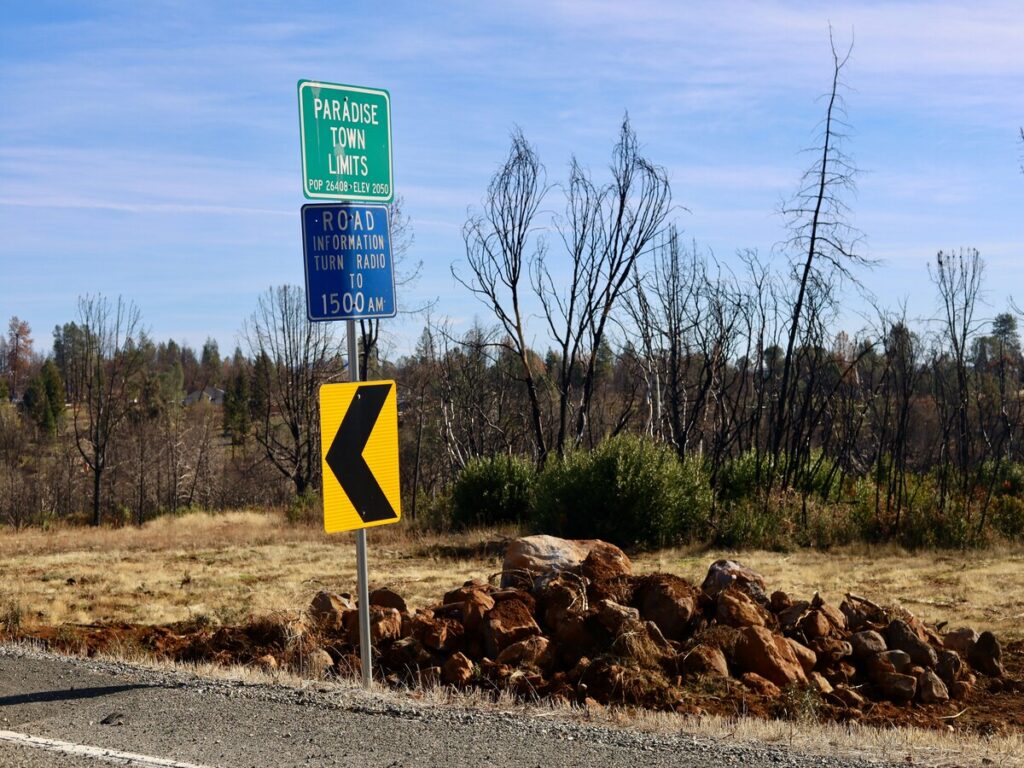
Häufige Fehler
Viele Einkaufsmanager sind verwirrt, wenn sie Schilder für andere Länder kaufen. Manchmal verwechseln sie die Klassen mit reflektierender Folie. Zum Beispiel, Einige wählen für Hauptstraßen den Engineer Grade. Aber diese Straßen brauchen hellere Schilder wie Diamond Grade. Dieser Fehler macht die Schilder nachts schwer zu erkennen. Einige Teams verwenden auch das falsche reflektierende Material für Verkehrsleitgeräte. Diese Fehler machen Schilder weniger sichtbar und gefährden Menschen.
Tipp: Überprüfen Sie immer die örtlichen Standards, bevor Sie Verkehrsschilder bestellen. Dies hilft, Fehler zu vermeiden und die Funktionsfähigkeit der Verkehrskontrollgeräte sicherzustellen.
Kosten und Compliance
Der Preisunterschied zwischen den Klassen reflektierender Folien kann Käufer überraschen. Hochwertigere Materialien wie Diamond Grade kosten mehr als niedrigere. Manche versuchen, Geld zu sparen, indem sie sich für günstigere Optionen entscheiden. Dies kann jedoch zu Problemen bei der Einhaltung der Regeln führen. Wenn ein Schild nicht den örtlichen Vorschriften entspricht, Das Projekt kann Geldstrafen erhalten oder neue Schilder benötigen. Dadurch wird das Projekt teurer und dauert länger. Bei der Einhaltung von Standards geht es nicht nur um das Gesetz. Es sorgt auch für die Sicherheit der Menschen im Straßenverkehr.
| Reflektierende Klasse | Typische Verwendung | Kostenniveau | Compliance-Risiko |
|---|---|---|---|
| Ingenieurqualität | Gebiete mit niedrigem Verkehr | Niedrig | Hoch |
| Hoher Intensität | Hauptstraßen | Medium | Medium |
| Diamantqualität | Hochgeschwindigkeitsstraßen | Hoch | Niedrig |
Lieferantenkoordination
Für den Kauf der richtigen Verkehrsschilder ist die Zusammenarbeit mit Lieferanten sehr wichtig. Die Teams müssen klar mit den Lieferanten sprechen, um Schilder zu erhalten, die zum Projekt und den örtlichen Vorschriften passen. Eine gute Kommunikation hilft, Fehler bei reflektierenden Planen und Verkehrsleitgeräten zu vermeiden. Gute Lieferanten beraten Sie zu den besten reflektierenden Materialien für jedes Schild. Sie helfen auch beim Papierkram und beim Nachweis, dass die Schilder den Regeln entsprechen. Diese Teamarbeit stellt sicher, dass alle Schilder sicher und gut sichtbar sind.
Notiz: Gute Lieferantenbeziehungen tragen dazu bei, dass Projekte gut verlaufen und die Funktionsfähigkeit der Schilder lange erhalten bleibt.
Wählen Sie beim Kauf von Verkehrsschildern reflektierende Folie
Die Auswahl der richtigen reflektierenden Folie für Verkehrsschilder in anderen Ländern erfordert einen klaren Plan. Jedes Projekt ist anders. Lokale Regeln und das Wetter können die Sache schwierig machen. This guide shows the main steps and things to think about when choosing the best reflective sheeting for traffic signs.
Assessing Project Needs
Teams need to know what their traffic signs must do. Reflective sheeting should make signs easy to see, sogar nachts oder bei schlechtem Wetter. Reflective films bounce back car headlights. This helps drivers spot signs and keeps roads safer. Signs also need to last a long time. They must handle tough places, like busy cities or faraway country roads.
Market research points out some important things to check:
| Key Consideration | Beschreibung |
|---|---|
| Sichtbarkeit und Sicherheit | Reflective materials help people see signs at night or in low light. This is very important for safety. |
| Vorschriftenregulierung | Materials must follow strict road safety rules in each country. |
| Haltbarkeit und Wetterbeständigkeit | Sheeting should last a long time, Auch bei schlechtem Wetter. |
| Technologische Fortschritte | Neue Dinge wie mikroprismatische Folien machen Schilder heller und funktionieren mit Smart-City-Systemen. |
| Regionale Marktdynamik | Regeln, Wetter, und Bauprojekte sind an jedem Ort unterschiedlich. Dadurch ändert sich, welche Materialien am besten sind. |
| Materialsegmentierung | Einige Folien sind reflektierend, manche nicht. Die Wahl hängt davon ab, wo und wie es verwendet wird. |
| Anwendungsfokus | Am meisten nachgefragt werden Verkehrsschilder. Diese brauchen starke, helle Folie, die den Regeln folgt. |
| Nachhaltigkeitstrends | Immer mehr Menschen wollen umweltfreundlich, biologisch abbaubar, und recycelbare Materialien, um der Umwelt zu helfen. |
Die Teams sollten darüber nachdenken, wie viele Autos die Straße benutzen, was für eine Straße das ist, und wie lange das Schild halten soll. Vielbefahrene Straßen oder wichtige Kreuzungen benötigen die beste reflektierende Folie. Auf ruhigen Straßen können niedrigere Steigungen verwendet werden. Damit Autofahrer schnell entscheiden können, müssen die Schilder immer gut lesbar sein.
Tipp: Überprüfen Sie das lokale Wetter. Sehr heiß, regnerisch, oder sonnige Orte können dazu führen, dass reflektierende Materialien schneller verschleißen. Wählen Sie eine Folie, die zum Wetter passt.
Zuordnung von Klassen zu Umgebungen
Die richtige Klasse von reflektierenden Folien hängt davon ab, wohin das Schild angebracht wird. Jede Klasse gibt einen anderen Helligkeitsgrad und eine andere Dauer an. Die Teams müssen den Reflexionsgrad an die Straße und deren Verkehrsdichte anpassen.
- Städtische Gebiete: Belebte Straßen mit vielen Menschen und Autos brauchen auffällige Schilder. Klasse 1 oder High-Intensity-Folie eignet sich hier gut.
- Autobahnen und Hauptstraßen: Schneller Verkehr und lange Distanzen erfordern die hellsten Schilder. Klasse 3 oder Diamond Grade-Platten eignen sich am besten für diese Straßen.
- Landstraßen oder verkehrsberuhigte Straßen: Diese Straßen können Class verwenden 2 oder Engineer-Grade-Folie. Es ist hell genug und kostet weniger.
- Besondere Umgebungen: Orte wie Baustellen, Schulen, oder Rettungswege benötigen die beste reflektierende Folie, um die Sicherheit aller zu gewährleisten.
So wählen Sie den richtigen Reflexionsgrad aus, Die Teams sollten sich ansehen, was jede Straße braucht. Schilder bei rauem Wetter oder an stark genutzten Orten benötigen möglicherweise mikroprismatische Technologie, um eine längere Lebensdauer zu gewährleisten.
Notiz: Informieren Sie sich stets über die aktuellen Verkehrszeichenvorschriften im Projektgebiet. Dadurch wird sichergestellt, dass die reflektierende Folie gut funktioniert und den gesetzlichen Bestimmungen entspricht.
Sicherstellung der Einhaltung von Standards
Die Einhaltung lokaler und weltweiter Standards ist bei jedem Verkehrszeichenprojekt sehr wichtig. Die Teams müssen überprüfen, ob alle reflektierenden Folien den richtigen Regeln entsprechen. Gute Aufzeichnungen zu führen ist ein wichtiger Teil davon.
- Zertifikate wie Form TR-0030 zeigen, dass temporäre Verkehrskontrolleinrichtungen bei Unfällen sicher sind.
- Eine Liste genehmigter Materialien hilft sicherzustellen, dass alle Schilder die richtige reflektierende Folie verwenden.
- Für einige Schilder sind Zulassungsbescheinigungen der Federal Highway Administration erforderlich.
- Bei Baugebietsschildern muss der Typ verwendet werden 3 oder besser retroreflektierende Folie von vertrauenswürdigen Herstellern.
- Durch Kontrollen und Inspektionen wird sichergestellt, dass die Schilder sowohl den Hersteller- als auch den gesetzlichen Vorschriften entsprechen.
Gruppen führen häufig eigene Kontrollen und Überprüfungen durch, um sicherzustellen, dass sie die Regeln einhalten. Diese Überprüfungen helfen, Probleme zu finden und Abhilfe zu schaffen. ISO 45001 Audits durch externe Experten liefern einen zusätzlichen Beweis dafür, dass die Regeln eingehalten und niedergeschrieben werden.
Tipp: Bewahren Sie alle Ihre Compliance-Dokumente ordentlich und leicht auffindbar auf. Dies hilft bei zukünftigen Kontrollen und sorgt für einen reibungslosen Projektablauf.
Bei der Auswahl einer reflektierenden Folie für Verkehrsschilder geht es um mehr als nur die Auswahl eines Typs. Die Teams müssen darüber nachdenken, wie gut das Schild zu erkennen ist, wie lange es dauern wird, die Regeln, und das Wetter. Indem wir einem klaren Plan folgen, Sie können sicherstellen, dass jedes Schild sicher ist und gut funktioniert.
Best Practices für grenzüberschreitende Projekte beim Kauf von Verkehrsschildern
Schritt-für-Schritt-Prozess
Ein einfacher Plan hilft Teams, Verkehrsschilder aus anderen Ländern zu kaufen. Erste, Projektmanager müssen sich an beiden Orten über die örtlichen Vorschriften für reflektierende Folien informieren. Nächste, Sie teilen den Lieferanten mit, was das Projekt benötigt, So weiß jeder, was ihn erwartet. Anschließend prüfen die Teams, ob die Lieferanten qualifiziert sind, und fordern Muster an, die den Regeln entsprechen. Danach, Sie schauen sich alle Papiere an, wie Zertifikate und Aufzeichnungen, um sicherzustellen, dass alles korrekt ist. Am Ende, Die Teams vereinbaren regelmäßige Treffen mit Lieferanten, um über den Stand der Dinge zu sprechen und Probleme schnell zu beheben.
| Schritt | Aktion | Zweck |
|---|---|---|
| 1. Identifizieren Sie Standards | Recherchieren Sie lokale und internationale Regeln | Achten Sie auf die richtige Klasse der reflektierenden Folie |
| 2. Signalnachfrage | Teilen Sie Projektanforderungen mit Lieferanten | Vermeiden Sie Missverständnisse |
| 3. Lieferanten überprüfen | Überprüfen Sie Ihre Referenzen und fordern Sie Muster an | Bestätigen Sie Qualität und Konformität |
| 4. Überprüfen Sie Dokumente | Untersuchen Sie Zertifikate und Compliance-Aufzeichnungen | Erfüllen Sie die gesetzlichen Anforderungen |
| 5. Laufende Meetings | Führen Sie regelmäßige Lieferantengespräche | Beheben Sie Probleme frühzeitig |
Fallstricke vermeiden
Der Kauf von Verkehrsschildern für Projekte in anderen Ländern kann schwierig sein. Teams wählen möglicherweise die falsche Klasse für reflektierende Folien oder vergessen wichtige Schritte. Um diese Fehler zu stoppen, Teams sollten frühzeitig mit Lieferanten sprechen und klare Worte verwenden. Geschichten aus China zeigen, dass die Nachfrage groß ist, Nachweis der Fähigkeiten, und Treffen helfen Lieferanten oft dabei, zu wissen, was benötigt wird. Zu den Teams sollten auch alle gehören, wie lokale Führer und Menschen, die die Straßen benutzen, um sicherzustellen, dass die richtigen Zeichen ausgewählt werden.
Tipp: Frühes Sprechen und Feedback verhindern oft große Fehler und sorgen dafür, dass das Projekt gut vorankommt.
Dokumentation und Zertifizierung
Mit den richtigen Papieren stellen Sie sicher, dass die Verkehrsschilder sowohl den australischen als auch den US-amerikanischen Vorschriften entsprechen. Regeln. Teams sollten Zertifikate wie sammeln ASTM D4956 für die Vereinigten Staaten und prüfen Sie auch die australischen Regeln. Der MUTCD Und staatliche Führer helfen den Teams auch dabei, herauszufinden, welche reflektierenden Folien zulässig sind. Das Ordnen aller Papiere hilft den Teams, bei Kontrollen oder Besuchen zu zeigen, dass sie die Regeln einhalten.
| Zertifizierungsstandard / Dokumentation | Beschreibung | Compliance-Region |
|---|---|---|
| ASTM D4956 | Norm für retroreflektierende Folien für Verkehrsleiteinrichtungen | Vereinigte Staaten |
| MUTCD | Bundesrichtlinie für Verkehrskontrollgeräte | Vereinigte Staaten |
| MN MUTCD | Landeshandbuch für Zeichenklassifizierungen | Vereinigte Staaten |
Notiz: Teams sollten Zertifikate und Aufzeichnungen immer auf dem neuesten Stand halten, um einen reibungslosen Projektablauf zu gewährleisten.
Unterschiedliche reflektierende Folienklassen können bei globalen Projekten zu Verwirrung führen. Die Teams müssen die örtlichen Regeln beachten, bevor sie Materialien auswählen. Sie sollten Leitfäden verwenden, um die Klassen zu vergleichen. Die Zusammenarbeit mit lokalen Lieferanten hilft allen, die Regeln einzuhalten. Außerdem ist es beim Kauf von Verkehrsschildern viel einfacher, über Bedürfnisse zu sprechen. Schulungen und Gespräche mit Lieferanten helfen Teams oft dabei, bessere Entscheidungen zu treffen. Wenn Teams diese Dinge tun, Projekte werden besser laufen und die Straßen werden für alle sicherer.
FAQ
Was ist der Hauptunterschied zwischen Australien und den USA?. Klassen für reflektierende Folien?
Australien verwendet Class 1, Klasse 2, und Klasse 3 für Zeichen. Die USA. verwendet Engineer Grade, Hoher Intensität, und Diamantqualität. Jedes Land prüft Helligkeit und Stärke auf seine eigene Weise. Dies kann bei der Zusammenarbeit mit anderen Ländern zu Verwirrung führen.
Warum ist die Wahl der richtigen reflektierenden Folienklasse wichtig??
Durch die Wahl der richtigen reflektierenden Folie bleiben Schilder gut sichtbar. Wenn Sie die falsche Klasse verwenden, Schilder können nachts oder bei Regen schwer zu erkennen sein. Dies kann zu Unfällen und Verstößen gegen örtliche Vorschriften führen.
Wie können Beschaffungsteams Fehler beim internationalen Kauf von Verkehrsschildern vermeiden??
Teams sollten sich vor dem Kauf von Schildern immer mit den örtlichen Regeln vertraut machen. Sie müssen klar mit den Lieferanten sprechen und einen Nachweis verlangen, dass die Schilder den Regeln entsprechen. Die Reflexionsklasse muss zur Straße passen, auf der das Schild angebracht werden soll.
Welche reflektierende Folienklasse eignet sich am besten für Hochgeschwindigkeitsstraßen??
Diamantgrad in den USA. oder Klasse 3 in Australien ist am besten für Schnellstraßen geeignet. Diese Klassen sind die hellsten und dauern am längsten. Sie tragen dazu bei, die Sicherheit aller auf stark befahrenen Straßen zu gewährleisten.
Welche Dokumente belegen die Einhaltung der Standards für reflektierende Folien??
| Dokumenttyp | Region |
|---|---|
| ASTM D4956-Zertifikat | Vereinigte Staaten |
| Als/nzs 1906 Zertifikat | Australien |
| MUTCD-Zulassung | Vereinigte Staaten |
Diese Papiere zeigen, dass die reflektierende Folie den richtigen Standards entspricht.

